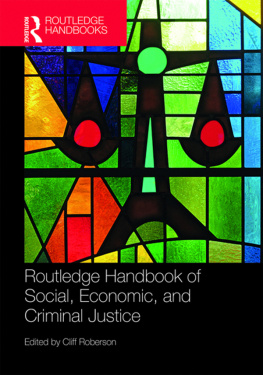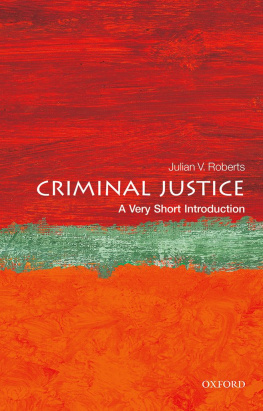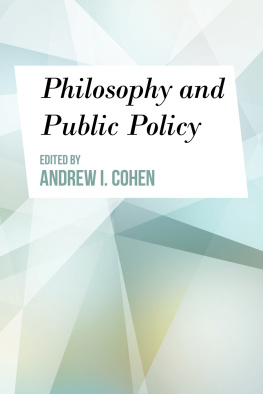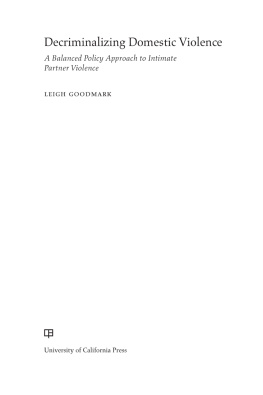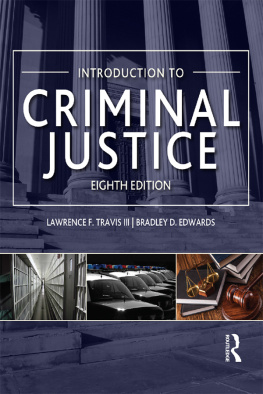Prisons and Punishment in America
Recent Titles in Contemporary Debates
The Affordable Care Act: Examining the Facts
Purva H. Rawal
Climate Change: Examining the Facts
Daniel Bedford and John Cook
Immigration: Examining the Facts
Cari Lee Skogberg Eastman
Marijuana: Examining the Facts
Karen T. Van Gundy and Michael S. Staunton
Muslims in America: Examining the Facts
Craig Considine
PRISONS AND PUNISHMENT IN AMERICA
Examining the Facts
Michael O'Hear
Contemporary Debates
Copyright 2018 by ABC-CLIO, LLC
All rights reserved. No part of this publication may be reproduced, stored in a retrieval system, or transmitted, in any form or by any means, electronic, mechanical, photocopying, recording, or otherwise, except for the inclusion of brief quotations in a review, without prior permission in writing from the publisher.
Library of Congress Cataloging-in-Publication Data
Names: OHear, Michael, 1968 author.
Title: Prisons and punishment in America : examining the facts / Michael OHear.
Description: Santa Barbara : ABC-CLIO, [2018] | Series: Contemporary debates | Includes bibliographical references and index.
Identifiers: LCCN 2018020529 (print) | LCCN 2018025353 (ebook) | ISBN 9781440855436 (ebook) | ISBN 9781440855429 (alk. paper)
Subjects: LCSH: PrisonsUnited States. | PunishmentUnited States.
Classification: LCC HV9471 (ebook) | LCC HV9471 .O44 2018 (print) | DDC 365/.973dc23
LC record available at https://lccn.loc.gov/2018020529
ISBN: 978-1-4408-5542-9 (print)
978-1-4408-5543-6 (ebook)
22 21 20 19 18 1 2 3 4 5
This book is also available as an eBook.
ABC-CLIO
An Imprint of ABC-CLIO, LLC
ABC-CLIO, LLC
130 Cremona Drive, P.O. Box 1911
Santa Barbara, California 93116-1911
www.abc-clio.com
This book is printed on acid-free paper 
Manufactured in the United States of America
Contents
Prisons and Punishment in America: Examining the Facts is the latest volume in ABC-CLIOs Contemporary Debates reference series. Each title in this series, which is intended for use by high school and undergraduate students as well as members of the general public, examines the veracity of controversial claims or beliefs surrounding a major political/cultural issue in the United States. The purpose of the series is to give readers a clear and unbiased understanding of current issues by informing them about falsehoods, half-truths, and misconceptionsand confirming the factual validity of other assertionsthat have gained traction in Americas political and cultural discourse. Ultimately, this series has been crafted to give readers the tools for a fuller understanding of controversial issues, policies, and laws that occupy center stage in American life and politics.
Each volume in this series identifies thirty to forty questions swirling about the larger topic under discussion. These questions are examined in individualized entries, which are in turn arranged in broad subject chapters that cover certain aspects of the issue being examined, that is, history of concern about the issue, potential economic or social impact, findings of latest scholarly research, and so on.
Each chapter features four to ten individual entries. Each entry begins by stating an important and/or well-known Question about the issue being studied. The entry then provides a concise and objective one-or two-paragraph Answer to the featured question, followed by a more comprehensive, detailed explanation of The Facts . This latter portion of each entry uses quantifiable, evidence-based information from respected sources to fully address each question and provide readers with the information they need to be informed citizens. Importantly, entries will also acknowledge instances in which conflicting data exists or data is incomplete. Finally, each entry concludes with a Further Reading section providing users with information on other important and/or influential resources.
The ultimate purpose of every book in the Contemporary Debates series is to reject false equivalence, in which demonstrably false beliefs or statements are given the same exposure and credence as the facts; to puncture myths that diminish our understanding of important policies and positions; to provide needed context for misleading statements and claims; and to confirm the factual accuracy of other assertions. In other words, volumes in this series are being crafted to clear the air surrounding some of the most contentious and misunderstood issues of our timenot just add another layer of obfuscation and uncertainty to the debate.
1
American SentencingLaw and Practice
Beginning in the mid-1970s, prison populations in the United States rose sharply and continuously for more than three decades (OHear, 2017, xiv). By the end of the imprisonment boom, the American rate of imprisonment had more than quintupled, from a long-term rate of 100 prisoners per 100,000 residents in the mid-twentieth century to a high of 527 per 100,000 in 2007.
The first half of the imprisonment boom coincided with similarly sharp increases in the rate of violent crime in the United States (OHear, 2017, xvi). However, crime rates have consistently fallen since the early 1990s. Still, even as crime rates dropped, imprisonment rates continued to climb for another decade and a half. This combination of a steadily declining crime rate and a steadily increasing imprisonment rate provides strong evidence that the U.S. criminal justice system became significantly tougher in the 1990s and early 2000s.
There are many actors in the system that could have contributed to this increased toughness, including (1) police officers, who decide whom to arrest; (2) prosecutors, who decide whether and how to charge the individuals who have been arrested; (3) judges, who decide how to sentence convicted defendants; (4) parole boards, which decide in many states when exactly sentenced defendants will be released from prison; and (5) community supervision agents, who decide whether convicted defendants who have been released on probation or parole should be revoked and sent to prison for violating the conditions of their release. In this chapter, we will focus particularly on the role of judges and prosecutors.
In addition, the work of another key player, the legislature, has to be considered. Congress and Americas fifty different state legislatures establish the legal framework within which judges and prosecutors do their jobs. Since the overwhelming majority of criminal cases in the United States are prosecuted in state courts under state law, the fifty state legislatures collectively play a far more important role in criminal justice issues than Congress, which only sets the rules for the comparatively few cases that are prosecuted in federal court. In any event, for every crime in a states criminal code, the legislature must establish a minimum and maximum sentence. These constitute the parameters within which prosecutors and judges exercise their discretionary power over punishment. For instance, for the crime of armed robbery, a given states legislature might prescribe a penalty of five to twenty years in prison. Thus, when a defendant in that state has been convicted of armed robbery and faces sentencing, the judge has the discretion to select a prison term of five years, twenty years, or any length of time in-between.



